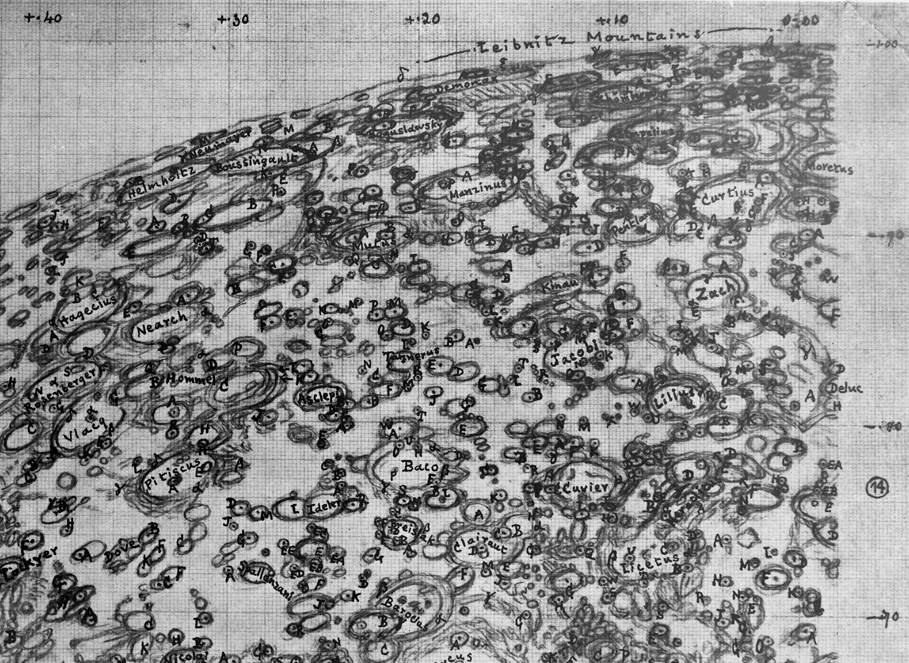|
|
| (7 intermediate revisions by the same user not shown) |
| Line 1: |
Line 1: |
| | __NOTOC__ | | __NOTOC__ |
| | =The Other B&M= | | =The Other B&M= |
| | + | <!-- Start of content --> |
| | + | <div class="post" id="post-1457"> |
| | | | |
| − |
| + | <div class="storycontent"> |
| − | <div class="post" id="post-1457">
| + | <p>[[File:B&M-1-LPOD.jpg|B&M-1-LPOD.jpg]]<br /> |
| − |
| |
| − | <div class="storycontent">
| |
| − | <p>[[File:B&M-1-LPOD.jpg|B&M-1-LPOD.jpg]]<br />
| |
| | <em>image from Blagg and Müller: </em><em>Named Lunar Formations</em>. South up. </p> | | <em>image from Blagg and Müller: </em><em>Named Lunar Formations</em>. South up. </p> |
| − | <p>In lunar history, B&M refers to Beer and Mädler, the wealthy banker and the sharp-eyed observer who published the most important lunar documents of the 19th century: <em>Mappa Selenographica</em> and the accompanying book, <em>Der Mond</em>. The B&M map was finely drafted and is a collector’s joy - I wish I had one! The portion of a map in today’s LPOD is of higher positional accuracy but much worse in legibility and style. This is the International Astronomical Union map, <em>[http://the-moon.wikispaces.com/Blagg+and+Müller?responseToken=8359c5c516be060fc74ffbcfaa3c7985 Named Lunar Formations]</em> of 1935, by Mary Blagg and Karl Müller. The IAU map consists of 14 sheets with a lunar diameter of 36.5″. The inner four sheets, drawn by W. H. Wesley, have slightly more elegance, but after he died, Miss Blagg, as she was always referred to, pencilled in the outer 10 charts on sheets of graph paper. She was an indefatigable student of the Moon, having compiled the <em>[http://the-moon.wikispaces.com/Collated+List?responseToken=4b8fbdef9a78906303335fa5f85e5563 Collated List of Lunar Formations]</em> in 1913, but she was not a draftsman. Although she did have the advantage of the Mt Wilson and other quality photographs, her chart of this crowded area of the southeast quadrant of the Moon is amateurish and hard to read. But as the title of the map and companion book stated, the purpose was to document the official IAU nomenclature. I used this B&M atlas extensively in the 1960s while working on the <em>[http://the-moon.wikispaces.com/SLC+Nomenclature?responseToken=4a0506f1c53ea82973f1e64e7d723622 System of Lunar Craters]</em> maps and catalogs, and can attest that it is very difficult to use and not always accurate. As I speculated earlier, the lack of clarity of this atlas probably provoked Fauth to create his own, cleaner [http://www.lpod.org/?m=20070905 map] of IAU nomenclature in 1936. </p> | + | <p>In lunar history, B&M refers to Beer and Mädler, the wealthy banker and the sharp-eyed observer who published the most important lunar documents of the 19th century: <em>Mappa Selenographica</em> and the accompanying book, <em>Der Mond</em>. The B&M map was finely drafted and is a collector’s joy - I wish I had one! The portion of a map in today’s LPOD is of higher positional accuracy but much worse in legibility and style. This is the International Astronomical Union map, <em>[https://the-moon.us/wiki/Blagg_and_Müller?responseToken=8359c5c516be060fc74ffbcfaa3c7985 Named Lunar Formations]</em> of 1935, by Mary Blagg and Karl Müller. The IAU map consists of 14 sheets with a lunar diameter of 36.5″. The inner four sheets, drawn by W. H. Wesley, have slightly more elegance, but after he died, Miss Blagg, as she was always referred to, pencilled in the outer 10 charts on sheets of graph paper. She was an indefatigable student of the Moon, having compiled the <em>[https://the-moon.us/wiki/Collated_List?responseToken=4b8fbdef9a78906303335fa5f85e5563 Collated List of Lunar Formations]</em> in 1913, but she was not a draftsman. Although she did have the advantage of the Mt Wilson and other quality photographs, her chart of this crowded area of the southeast quadrant of the Moon is amateurish and hard to read. But as the title of the map and companion book stated, the purpose was to document the official IAU nomenclature. I used this B&M atlas extensively in the 1960s while working on the <em>[https://the-moon.us/wiki/SLC_Nomenclature?responseToken=4a0506f1c53ea82973f1e64e7d723622 System of Lunar Craters]</em> maps and catalogs, and can attest that it is very difficult to use and not always accurate. As I speculated earlier, the lack of clarity of this atlas probably provoked Fauth to create his own, cleaner [[September_5,_2007|map]] of IAU nomenclature in 1936. </p> |
| | <p>[mailto:tychocrater@yahoo.com Chuck Wood]</p> | | <p>[mailto:tychocrater@yahoo.com Chuck Wood]</p> |
| − | <p><em>Now you can support LPOD when you buy any book from Amazon thru [[LPOD]]</em></p> | + | <p><b>Yesterday's LPOD:</b> [[October 19, 2007|Troughful Magnificence]] </p> |
| − | </div>
| + | <p><b>Tomorrow's LPOD:</b> [[October 21, 2007|A Wonderful Corner]] </p> |
| − |
| + | <!-- Removed reference to store page 2 --> |
| − | | + | </div> |
| − | ---- | + | <!-- End of content --> |
| − | ===COMMENTS?===
| + | {{wiki/ArticleFooter}} |
| − | Click on this icon [[image:PostIcon.jpg]] at the upper right to post a comment.
| |




